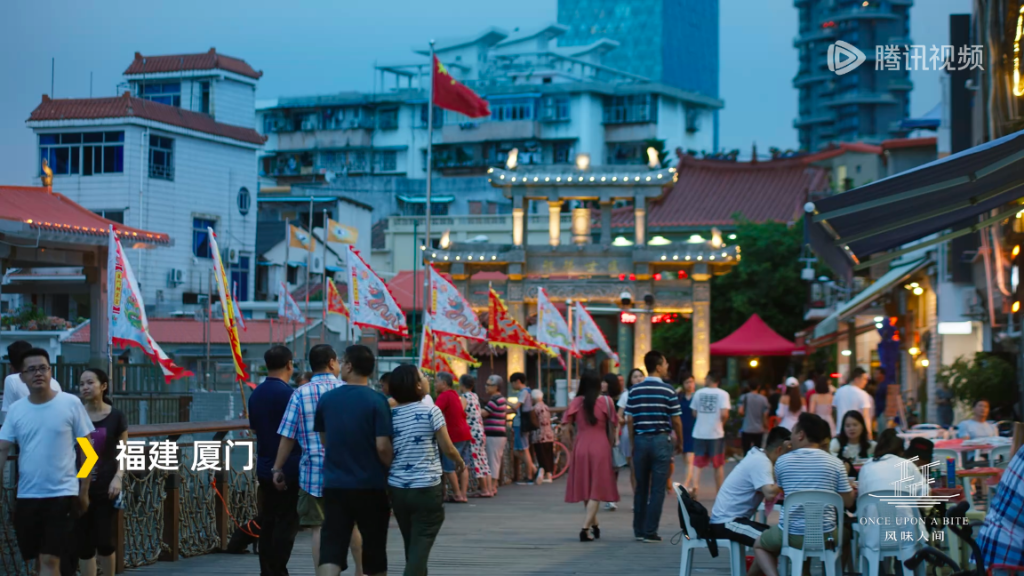
"Flavorful Origins" is a food exploration documentary, which was filmed for 5 seasons in 8 years, leading the audience to examine the uniqueness of Chinese cuisine from a global perspective, and from the historical evolution of food to the deep connection between people and food. The fifth season, "Flavorful Origins: Legend of Spice", which will be broadcast at the end of 2024, focuses on the theme of spices for the first time, telling how spices have influenced the world in the wave of globalization and become the personality label of regional cuisine. At the same time, it also shows the world the important position of spices in the exchange of Chinese cuisine and global culture.
Continuing the popularity of "The Legend of Spice", the "Flavor" Tour - Flavors of Xiamen and Fragrance of Southeast Asia was held in Xiamen, Fujian Province. Chen Xiaoqing, the chief director of the "Flavor of Xiamen" series, visited the "Eight Markets" and Zhongshan Road in Xiamen to experience the special food market, feel the unique "tea table" of southern Fujian, and explore the flavors of Xiamen.

Stills from "Flavorful Origins: Legend of Spice"
Talking to the world through spices
Xiamen has been an important hub of the Maritime Silk Road since the Song and Yuan Dynasties. The long history of immigration to Southeast Asia and frequent overseas trade have deeply influenced Xiamen cuisine. The taste of Xiamen is not only a taste bud enjoyment, but also a cultural memory across the ocean. It also fully demonstrates how Southeast Asian spices and food are integrated and gradually influence the local food culture.
In the book "Flavorful World·Legend of Spice", the most unique spice among all kinds of spices in Xiamen is presented - peanuts. When peanuts are separated from the form of nuts and made into peanut butter, they retain the mellow natural aroma of nuts and add the silkiness of oil.

Stills from "Flavorful Origins: Legend of Spice"
But in Xiamen, peanuts are incorporated into a popular local sauce, shacha sauce. The rich nutty aroma of peanuts enriches the flavor of shacha sauce and also harmonizes the spicy taste of various peppers in shacha sauce.
Lin Weihui, food consultant and writer of "Flavorful Origins", said Xiamen is a city full of shacha sauce. "Behind the food are ethnic groups, and along with ethnic groups is cultural heritage. As soon as we taste shacha sauce, we know it is not Chinese. It has a strong flavor from Southeast Asia. It is the flavor brought back from Southeast Asia by the Minnan and Chaoshan people. The shacha sauce of Minnan is slightly sweeter, while that of Chaoshan is fresh."

Shacha Noodles
Humanities scholar Peng Jun believes that spices are an important language for China to communicate with the world. Another important ingredient in shacha sauce is chili peppers. "Chili peppers were introduced to the Central Plains from the Western Regions during the Han Dynasty. But what you may not know is that chili peppers later traveled across the ocean to Southeast Asia as Xiamen became an important port. They met various spices in Southeast Asia and became shacha sauce. This is a story of wandering, searching and ultimately returning."
When we smell mint, we think of Yunnan, and when we smell litsea cubeba, we think of Guizhou. "When you smell the flavor of shacha, you know you have arrived in Xiamen," said Peng Jun.
This flavor journey began with an "old-fashioned" brunch. On the table were foods cooked with ingredients that were very representative of Xiamen's local flavor, such as red mushroom and river chicken soup dumplings, Baijiacun fried tofu and oyster omelette, garlic sauce, earthworms and Tong'an ginseng-flavored yam, Ludao seafood noodle soup with fried dough sticks, soy sauce mango with Laobashi peanut soup, etc.

Oyster Omelette

Groundnut Jelly
Lin Weihui said that in the episode "The Friendship of Onions and Garlic", a spice of Chaoshan, Dongcai, was mentioned, and its history can be traced back to the Second Opium War. At that time, Shantou was forced to be an open port, and merchants from Tianjin brought Jin Dongcai to Chaoshan. Jin Dongcai became the flavor of Chaoshan and also became a very unique symbol of Chaoshan.
Finding the flavors of Xiamen
On the open-air big screen on Zhongshan Road in Xiamen, the trailer of "Flavorful Origins: Legend of Spice" was playing in a loop.

Xiamen Zhongshan Road
Chen Xiaoqing introduced that the kingdom of spices is very large and complex, and is widely used. "Fennel is divided into big anise and small fennel. Big anise is star anise, but we can't put small fennel in the slices. Small fennel is the most widely used in Chinese marinades. Whether it is Chaoshan, Sichuan, or even northern marinades, it is indispensable. However, because it is used too widely, it seems to have lost its characteristics. We can only reluctantly give up such spices."
The theme of this event is "Exploring the Flavors of Xiamen". Chen Xiaoqing said, "Almost all the spices on this planet can be found in Xiamen. Moreover, Xiamen's spices are particularly complex in the seasoning system. Take acid as an example. There is acetic acid caused by rice koji, sourness from fruits directly added, and simple fermented acid like turnip acid. Xiamen's spices are like the flamboyant phoenix flowers, very gorgeous."
In today's Xiamen's characteristic "Eight Markets" and Zhongshan Road, exploring the unique food shops in the downtown area, you can directly experience what Chen Xiaoqing called the "gorgeous and flamboyant" of Xiamen's various ingredients and spices.

Xiamen Eight Cities
In a street park in the "Eight Markets", 15 local specialty food stalls are open, and everyone can enjoy "tea table" with local residents. People in southern Fujian love to drink tea. Under the arcade, they put a tea table with tea and snacks, and drink tea and chat. This unique "tea table" culture is not only a common memory in the hearts of many old Xiamen people, but also reflects the distinct personality of the city. This down-to-earth tea culture gathers the fireworks of the city.

"Tea Table"

"Flavor" Exhibition
The "Exploring Xiamen" team also watched the food production process up close and enjoyed the special intangible cultural heritage performances of "Puppet" and "Nanyin". The story of spices was transferred from the images on the screen to reality. In the actual contact that can be seen and eaten, the humanistic significance behind the food can be better appreciated.

Nanyin Performance
Peng Jun introduced that in addition to spices, another label of Xiamen is tea. "Xiamen is the first gate of the Tea Horse Road. There are so many teas that are exported from Xiamen. Xiamen's tea is all-encompassing." It is worth mentioning that Queen, another organizer of this event, combines spices with tea, and uses different cooking methods to make teas with different flavors by adding fruits, spices and other ingredients to the special teas from each place in Fujian.

Various tea drinks
The story of spices is still going on. At the theme dinner, Queen also launched the "Symphony of Spices Singing Around the Fire" special "flavor" menu based on the seven spice themes in "Flavorful World 5: Legend of Spices" and the Minnan nursery rhyme "Song of the Fireside". The menu integrates spices, Minnan customs, Fujian cuisine and Nanyang flavors. Through dishes such as Malay curry meat, tomato extract fish, red curry lobster, reunion fireside noodles, and turtle cake, various spices are used to give each dish a unique flavor.

"Flavor" Dinner
Zhu Lexian, producer of "Flavorful Origins", believes that it is necessary to enrich the depth and breadth of content from different dimensions. "In addition to the traditional licensing model, we are also diversifying and expanding. The offline experience of this "Flavorful Journey" is a brand-new model. There may be more activities in the future to convert the popularity of the program into offline consumption power and regional influence."

“Explore Xiamen”
